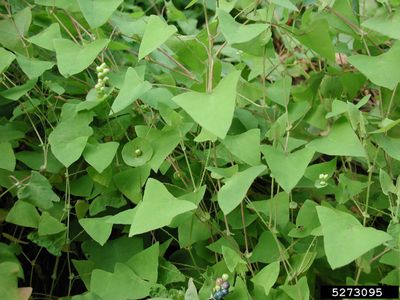What is Mile a Minute Weed?
Mile-a-minute weed grows fast, and that’s a fact. Experts say that these prickly annual vines can grow up to 6 inches in 24 hours, and are much akin to kudzu! The vines germinate in early spring, then grow amazingly fast, growing on top of and smothering out neighboring plants. The white flowers are followed by berry-like fruit. The vine dies off by the first frosts, but not soon enough to prevent its spread. Each individual plant can produce thousands of seeds, and these are spread far and wide by birds, mammals, wind and water. Therein lies the problem: they do spread. Mile-a-minute weeds grow happily in any disturbed area and invade forested floodplains, streamside wetlands and upland woods.
Mile a Minute Weed Control
If you are interested in getting rid of mile-a-minute weeds in your garden or backyard, don’t despair. Mile-a-minute weed control is possible.
Herbicides
One way of controlling mile-a-minute weeds is to spray them with a foliar non-selective herbicide treatment, which passes into the plants’ roots and kills them. Use a 1 percent mix and apply after mid-July. Chemical control should only be used as a last resort, as organic approaches are more environmentally friendly.
Mechanical Controls
You can also start controlling mile-a-minute weeds by using force. Pull them up by hand or mow them down. If this seems like too much work, an easier method of control involves livestock. Bringing in goats or sheep for targeted grazing also works well. This is particularly useful in areas that are difficult to access with machinery. When you are getting rid of these weeds, don’t forget that your primary task is to prevent the seeds from spreading. Chop out the vines or spray them before the seeds are mature, and keep your eye out for new vines developing.
Biological Control
You can also bring in reinforcements in the fight with the weeds in the form of mile-a-minute weevils, Rhinocominus latipes Korotyaev. These tiny insects are host specific to mile-a-minute weed plants and can control this invasive vine. How do they destroy the weed? Mature females lay their eggs on the vine’s leaves and stems. The eggs turn into larvae which bore into and feed on the vines’ stems. Adult weevils also eat the leaves and then spend the winter in the fallen leaf litter. Note: Any recommendations pertaining to the use of chemicals are for informational purposes only. Chemical control should only be used as a last resort, as organic approaches are safer and more environmentally friendly
